Get to know some of the blooms you’ll encounter during your visit to the gardens!
Tohono Chul’s gardens feature a stunning variety of plants in full bloom year-round, providing visitors with a unique opportunity to witness the vibrant colors and textures of desert flora. From the wildflowers of spring to the vibrant monsoon blooms of summer, there’s always something new to discover. Explore the lush landscapes of Tohono Chul and immerse yourself in the beauty of desert plants in bloom.
Summer Blooms

The enduring icon of the Sonoran Desert is the Saguaro, Carnegiea gigantea. Towering over their surroundings, each cactus begins life as a tiny seed no bigger pinhead, hidden beneath the protective arms of a nurse tree. The Arizona state flower, saguaro blooms open in the evening to feed hungry bats and stay open into the following day to also be pollinated by White-winged Doves.

Southwestern Coral Bean (Erythrina flabelliformis) is a frost-sensitive, winter deciduous shrub or small tree. Its striking, long, tubular scarlet flowers appear in clusters generally before the plant leafs out in May. Not unexpectedly, hummingbirds love them. The flowers, however, are followed by large seed pods with highly toxic bright red seeds.

Native Watson’s Dutchman’s Pipe (Aristolochia watsonii) is truly underwhelming when it comes to flowers, but this trailing vine with arrow-shaped leaves is the larval plant of the Pipevine Swallowtail butterfly. Interestingly, the flowers are pollinated by small blood-sucking flies that mistake the flowers for mouse ears. Trapped inside overnight, the flies get a dusting of pollen before being released in the morning.

A number of hybrids have been developed from our native Yellow Bells (Tecoma stans) that ramp up the bright yellow color of the original – from deep orange to color blends that mimic an Arizona sunset. This mostly evergreen, perennial shrub provides prodigious summer color, is rabbit resistant and attractive to hummingbirds.

Native to the Chihuahuan Desert, Beebrush (Aloysia gratissima) is known as Jazminillo in Spanish, meaning jasmine. It’s no wonder, as its white flower stalks, usually appearing after rains spring through fall, are scented like vanilla. Bees attracted to the flowers produce a delicious honey from their nectar. Also appreciative of the nectar as adults are butterflies like Ceraunus Blue and Great Purple Hairstreak.

Ruellia peninsularis, aka Ruellia, is one of those Sonoran Desert-Baja California natives that will actually do well with some shade. A naturally rounded, leafy shrub, it produces masses of purple petunia-like flowers most of the growing season. It can be grown as an effective hedge and though drought tolerant, does better with some supplemental water. A larval plant for Texan Crescent butterflies, hummingbirds come for the nectar.

Take one look, and it is fairly obvious which of our desert critters is attracted to Desert Honeysuckle (Anisacanthus thurberi). Classically tubular-shaped and the color of orange clay, its flowers evolved to fit a hummingbird’s beak. Native to Arizona and New Mexico, the blossoms also provide nectar for adult butterflies, while the leaves serve as larval food for Elada Checkerspots.

Heat-loving Red Bird of Paradise (Caesalpinia pulcherrima) likely got its common name for its resemblance to the tropical avian Bird of Paradise. The colorful, flamboyant flowers and exuberant stamens mimic the bird’s feathers on display. A common landscape plant in southern Arizona, Red Bird is native to Mexico and the West Indies and its red-orange flowers feed both butterflies and hummingbirds.

As its name implies, Woolly Butterfly Bush (Buddleja marrubiifolia) is all about butterflies. A Chihuahuan Desert native, it takes the heat of summer, small hairs on its gray-green leaves giving a fuzzy appearance while protecting it from excessive sun. The peculiar ball-shaped flowers provide nectar for insects such as Gulf Fritillary and Pipevine Swallowtail; hummingbirds have even been seen taking a sip.
Spring Blooms

The Cactus Circle, home to Kioko Mwitiki’s “Horse,” is planted with Mexican Fencepost cacti (Pachycereus marginatus), an unintended “corral” for this well-loved Tohono Chul icon. Vertical to 12’, Fencepost cacti can be used for screening out those pesky neighbors or keeping your own “horse” corralled.

It’s easy to see where Desert Bluebells get their name – they look like little bells. Phacelia campanularia ssp. campanularia is limited to the Sonoran Desert and is relatively easy to grow. A word of caution though, their hairy stems and leaves can cause contact dermatitis – another reason not to pick them!

Regardless of the date on the calendar, for many, their first sight of a Mexican Gold Poppy means spring is here. Once considered a separate species from the bigger, more orange California Poppy, Escholzia californica ssp. mexicana is actually a desert-loving subspecies. Its Spanish name – amapola del campo – translates as “poppy of the countryside.”

Eaton’s Penstemon (Penstemon eatonii) is beloved of hummingbirds and should have a place in your desert garden. Sun-loving Firecracker Penstemon, as it is commonly referred to, is easily identified by its tubular, scarlet flowers which appear from late spring into summer. Incidentally, it is considered rabbit resistant.

Arizona Twistflower aka Streptanthus carinatus ssp. arizonicus looks like someone’s puckered lips about to bestow a kiss. A member of the mustard family, these annuals with their white to cream flowers appear in the spring throughout the southern reaches of the Sonoran Desert and into the Chihuahuan Desert.
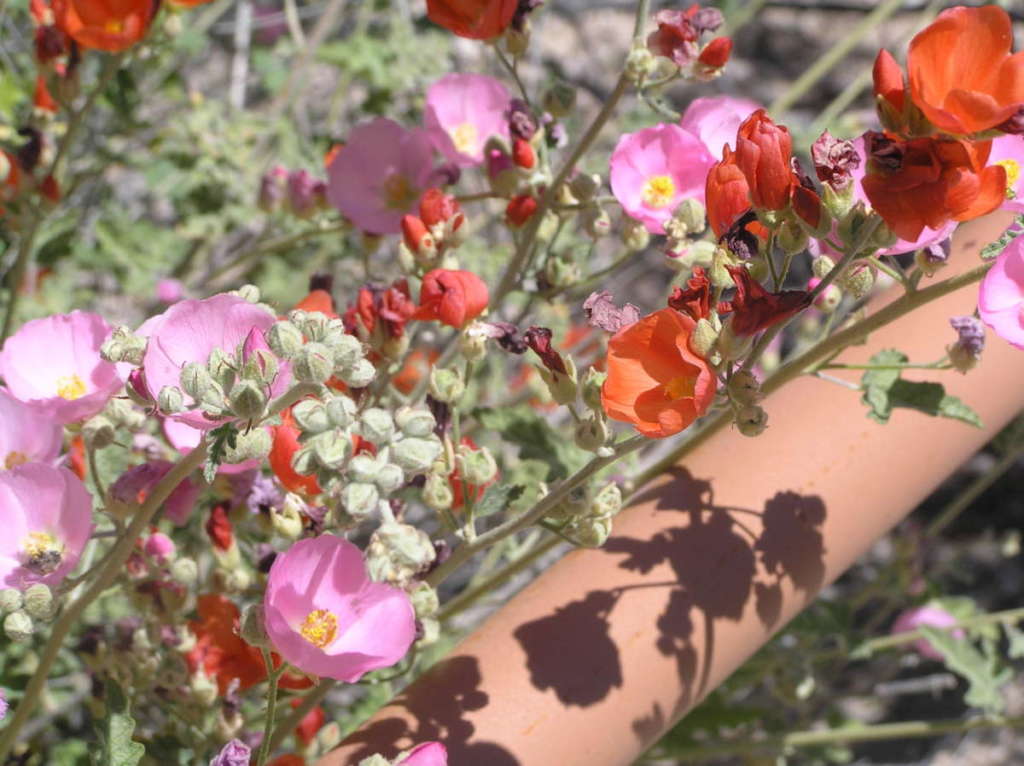
If you travel in certain areas of the Arizona Upland, it seems that Desert Globemallow comes in more colors than the rainbow – there’s the orange we are most familiar with, and then there’s red, pink, lavender and white. Sphaeralcea ambigua is a hardy, drought tolerant perennial that attracts native bees.

Englishman Charles C. Parry was a surgeon/botanist with the U.S. and Mexican Boundary Survey in the mid-19th century. One of the plants he “discovered” and named is Parry’s Penstemon (Penstemon parryi), a showy, native spring perennial noted for its 2’ to 5’ stalks of bright pink flowers.

Encelia farinosa aka Brittlebush is a common sight in the foothills of the Santa Catalina Mountains in March and April. One clue to its membership in the sunflower family of plants, is its daisy-shaped yellow flowers. The Spanish name for brittlebush is incienso; the dried resin that falls from its flower stems can be burned as a fragrant incense.

Remember when Meg Ryan said daisies were such happy flowers? That can certainly be said about Blackfoot Daisy (Melampodium leucanthum), low-growing mounds of perky white flowers with yellow centers. Did you know that what we think of as a single daisy flower is actually a cluster of individual flowers? The “petals” are flat ray flowers and the center is made up of tiny disc flowers.

Desert Marigold (Baileya multiradiata) is another member of the sunflower family found growing along graveled roadsides throughout southern Arizona. Fine hairs growing on its leaves contribute to its desert adaptations by reflecting sunlight. A spring bloomer, adequate rains can extend Marigold bloom time into summer and fall.
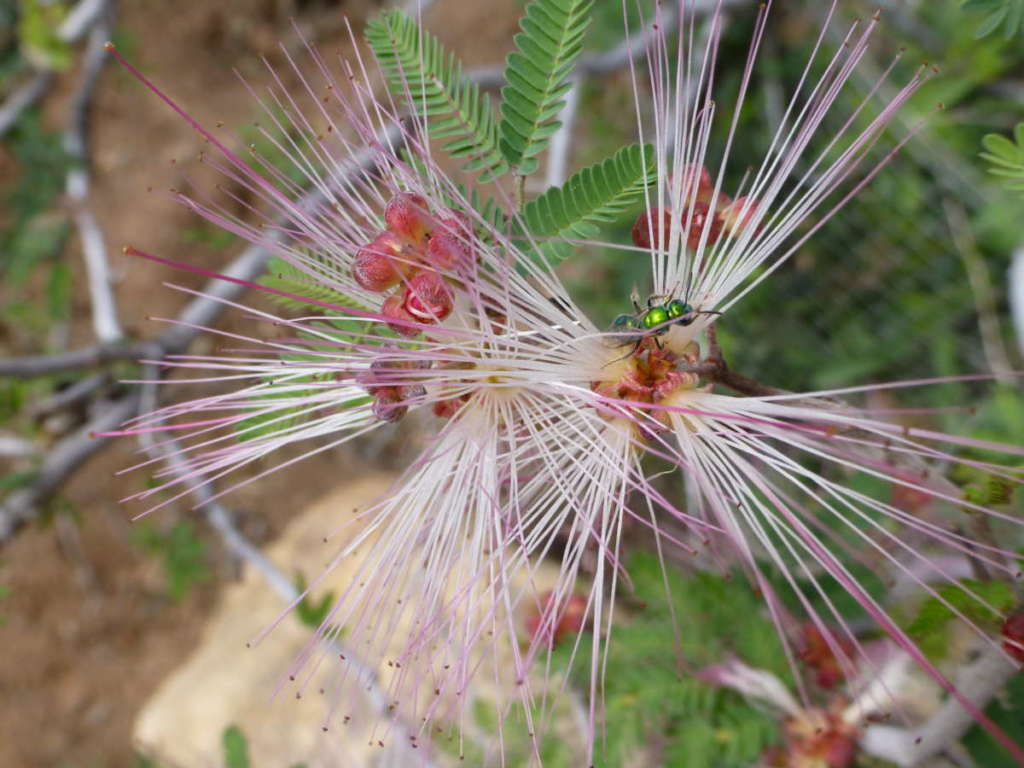
Tough as nails Fairyduster is easy to overlook most of the year, but with the advent of spring, Calliandra eriophylla shouts its presence with a display of the most amazingly fluffy pink flowers. Those “flowers” are all stamens, with only tiny, inconspicuous petals and are highly attractive to both butterflies and hummingbirds.

Goodding’s Verbena (Glandularia gooddingii), a Sonoran Desert native, is an excellent nectar source for adult butterflies. Its lavender-purple flowers form in clusters appear in the spring and with supplemental water, will hang on into the fall. An excellent groundcover, the spreading plant helps the soil retain moisture and stay cooler.

“Wallflower” is a name usually given to someone shy and retiring – that certainly cannot be said about Western Wallflower (Erysimum capitatum) which can grow over a yard tall! The yellow to orange flower clusters are great nectar sources for butterflies and are pollinated by native bees.
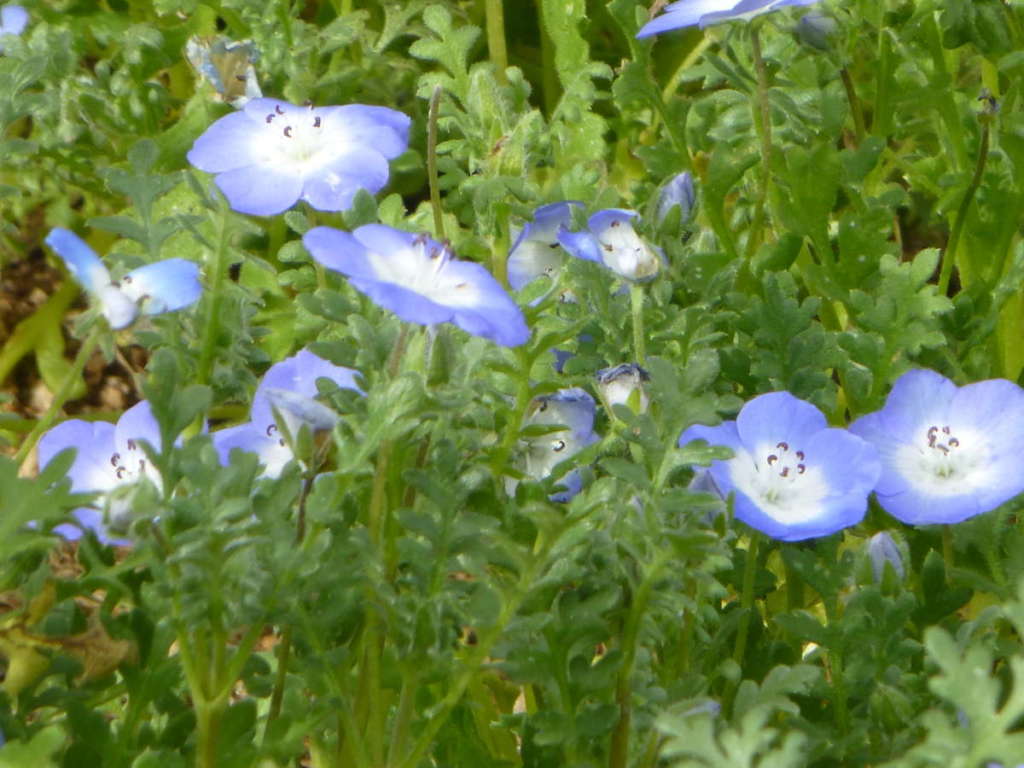
Nemophila menziesii, otherwise known as Baby Blue Eyes, is a native of Baja California and common throughout California. A low-growing, spreading annual, its cup-shaped baby blue flowers have white centers and prominent stamens. It is considered to be of special value to native bees.
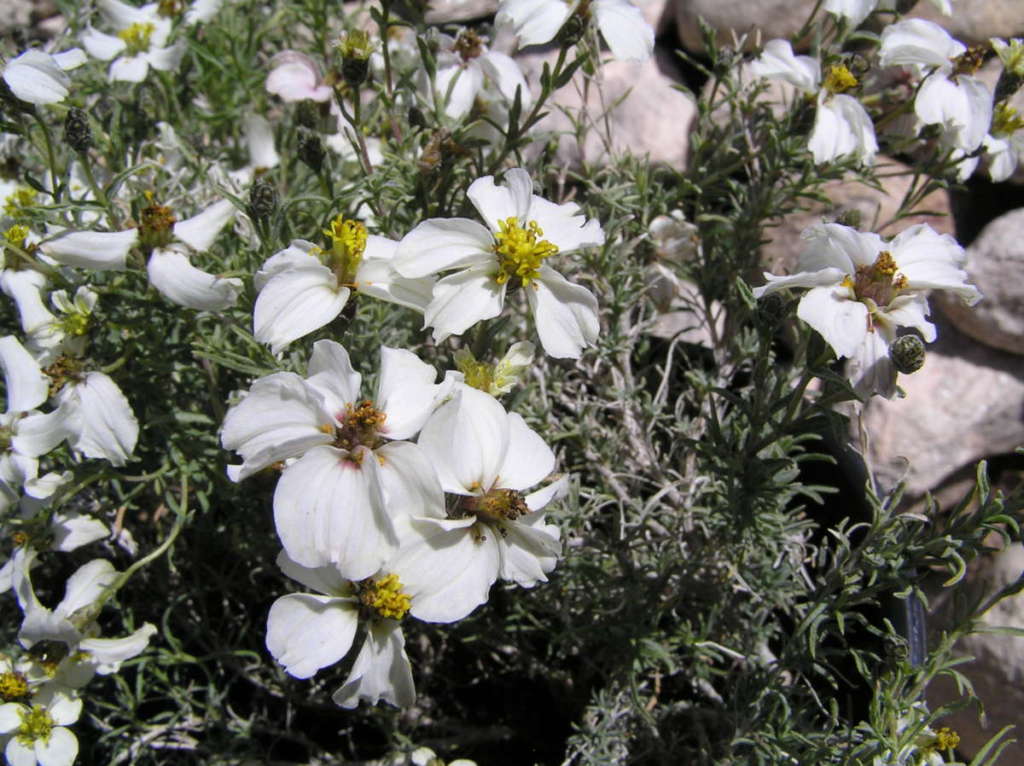
Desert Zinnia (Zinnia acerosa) is another member of the sunflower family native to central and southern Arizona. It blooms earlier on the grounds than in the wild due to supplemental water, and will keep blooming into early fall. The whitish petals fold downwards, drawing attention to the deep yellow central disc flowers, the target of hungry butterflies.

What is a weed? To some, Spreading Fleabane qualifies. Erigeron divergens can be invasive, especially if it is growing where you don’t want it. An early and prolific bloomer, Fleabane got its common name from the mistaken belief that dried flowers would rid one’s house of fleas. On the bright side, the caterpillars of several moth species feed on the plants.

Nama hispidum is usually just referred to Nama, a small name for a small, belly flower – and a belly flower is one you have to get down on your belly to see. This ground-hugger can be spotted not just in open areas, but sticking out of cracks in the pavement, succulent, hairy green stems supporting half-inch, bell-shaped, purple flowers. Summer rains can result in a second bloom.

Mexican Honeysuckle (Justicia spicigera) is native to Mexico and Central America. An evergreen shrub that does well in filtered shade and is highly tolerant of our extreme heat, its tubular orange flowers are a lure for hummingbirds, and the occasional butterfly, from spring into fall.

Its flowers used in the production of perfume, Sweet Acacia (Vachellia farnesiana) is a fragrant reminder of spring. Fine green leaves are offset by bright yellow fuzz-balls and paired spines. While its origin is disputed – Central America, Mexico or the Caribbean, Sweet Acacia is a common landscape tree in Tucson, its umbrella shape can grow to 30’.
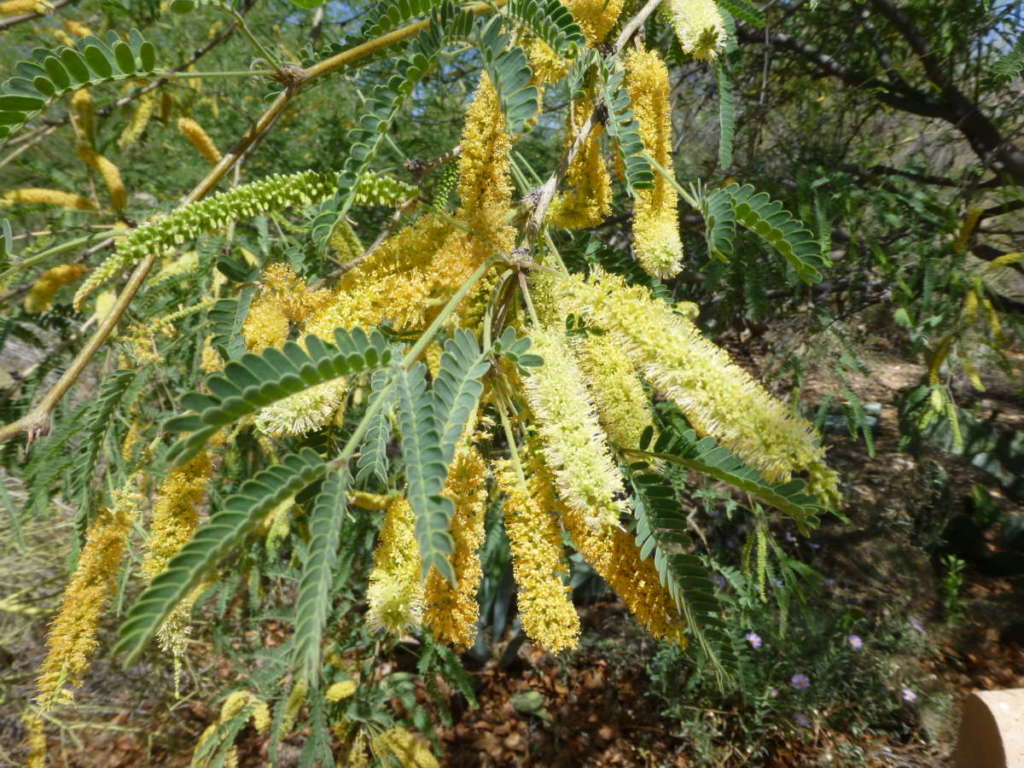
Named for the fine hairs covering its compound leaves, Velvet Mesquite (Prosopis velutina) is a bee magnet. Its yellow catkins, so called because of their resemblance to a kitten’s tail, provide nectar and pollen that becomes delicious local honey. Ground seed pods once fed native peoples and are making a comeback as heart healthy fare.
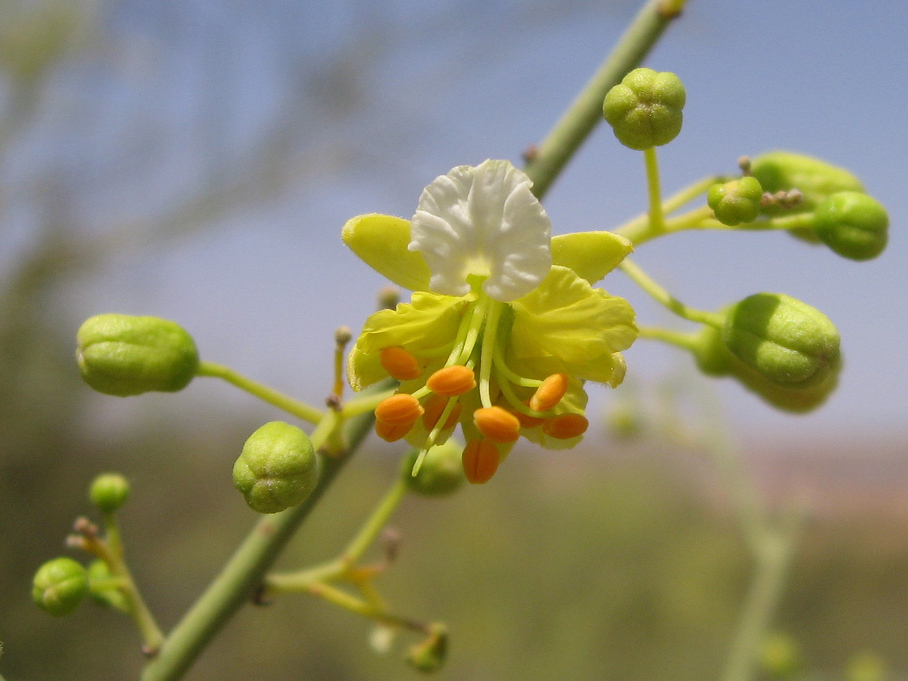
Foothills Palo Verde (Parkinsonia microphylla) is the “signature” tree of the Arizona Upland subdivision of the Sonoran Desert, as well as being Arizona’s state tree. Chlorophyll in the bark provides the green coloration – palo verde is Spanish for green stick – and allows the tree to perform photosynthesis even when leafless during droughts. Mid-spring yellow pea flowers are notable for their creamy banner petal.

The “other” state tree is the Blue Palo Verde (Parkinsonia florida). Blooming earlier in the spring than the Foothills, the yellow flowers of the Blue Palo Verde are distinguished by orange spots on the banner petal. What’s a banner petal? That’s the larger, upstanding petal that surrounds two wing petals which in turn, bracket two smaller keel petals. These kinds of flowers are indicative of the legume family.

The Desert Willow (Chilopsis lineraris) is not a true willow, despite its long, narrow leaves and drooping branches. A winter deciduous tree, April through August large white to lavender-pink orchid-like flowers appear; new color varieties in the nursery trade range from pale lavender to burgundy. Native to both the Chihuahuan and Sonoran Deserts, Desert Willow is fast growing, easy to maintain and very drought tolerant.
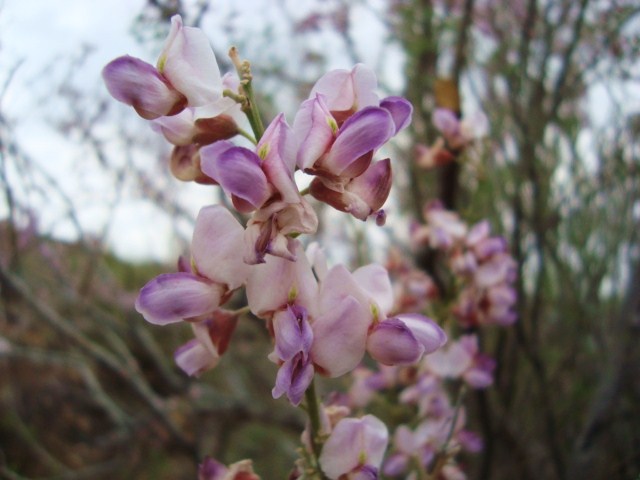
The longest-lived of our desert trees is Ironwood (Olneya tesota). While cold temperatures limit its northern range, Ironwood does well in parts of Tucson where freezing nights are at a minimum. Very slow-growing with dense wood, the Seri Indians of western Sonora have used the tree for desert- and sea-themed wood carvings. The tree drops its leaves before dainty, lavender flowers appear in May.

Unlike their agave cousins, yuccas will bloom more than once in their lifetimes. Soaptree Yucca (Yucca elata) produces a 3’ to 7’ tall flower stem covered with clusters of cream-colored, bell-shaped flowers. An interesting mutualistic relationship exists between the plant and a tiny Pronuba moth. In return for pollination services, the yucca’s seeds provide sustenance for the moth larvae.

Technically, Ocotillo (Fouquieria splendens) is a shrub – no, not a cactus and not really a succulent either. They do have spines, though, which are actually the hardened petioles of the leaves on new growth. Ocotillo are supremely adapted to their native Sonoran and Chihuahuan Deserts, dropping leaves in time of drought and then leafing out and even blooming within days of measurable rain.

Echinocereus engelmannii or Hedgehog is the most common Hedgehog cactus in the Tucson area. The less than 12” tall stems grow in clusters and are armored with slightly curved spines in groups of shorter radials and four longer central spines; flowers range from light pink to deep magenta. And the name? 19th century German physician and botanist George Engelmann is responsible for the descriptions of more than 100 cactus species.

Besides the saguaro, the Prickly Pear (Opuntia engelmannii) is probably the most recognized cactus species. While their relative, cholla, has cylindrical stems, those of prickly pear are flattened and covered with tiny, razor-sharp spines called glochids. Known as nopal in Spanish, the young pads as well as the ripened fruit are edible and once were staples in Sonoran households.

One of several cholla species in the Tucson area, Staghorn Cholla (Cylindropuntia versicolor) is noted for its range of flower color – red, yellow, purple or even greenish-bronze. Harvested by the O’odham and the Hohokam before them, unopened cholla buds were the first fresh food after a long winter. Stripped of their spines and boiled or roasted, they have a taste similar to asparagus.
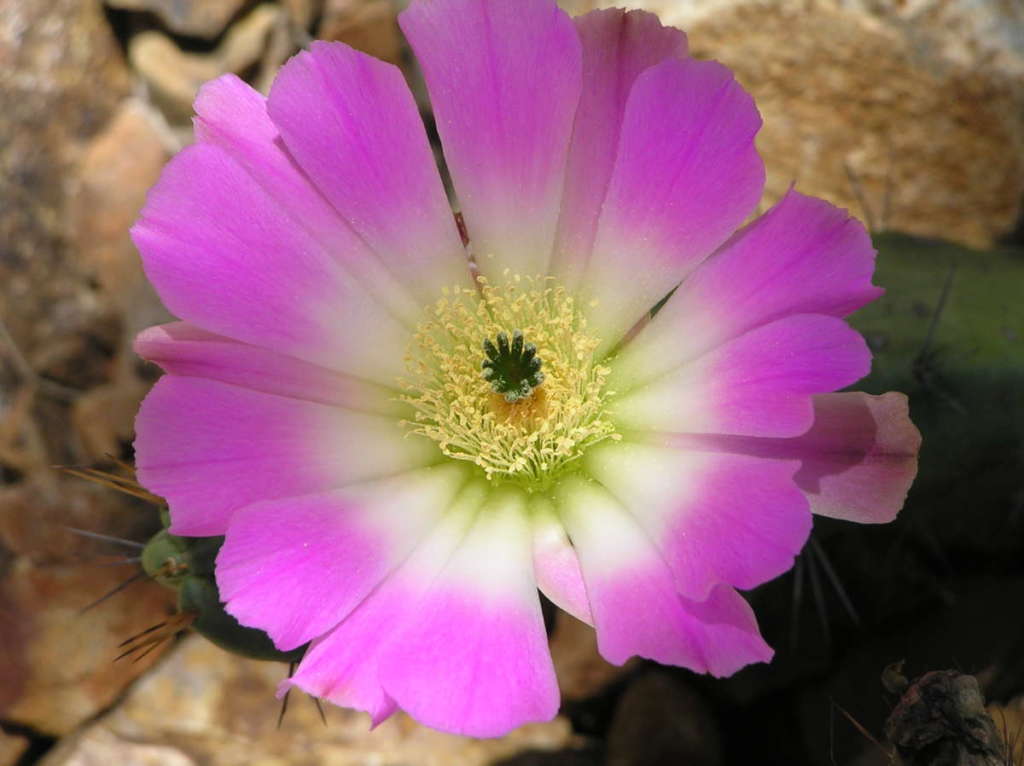
Alicoche aka Lady Finger Cactus (Echinocereus pentalophus) is a stunner, with mass blooms of magenta-pink flowers opening overnight in late spring. With its prostrate growth pattern, it can be troublesome as a container plant; be prepared for it to overwhelm a pot and make its own way along the ground.

“Century plants,” otherwise known as Agaves, don’t take 100 years to bloom, but when they do, they do it just once before they die. Agave americana,native of the Sonoran Desert in Mexico, is common around Tucson. Easily growing up to 10’ x 10’ it’s flower stalk is was impressive, sometimes making it to 24’ tall. Nectar-rich flowers are a draw for migrating fruit bats.

Named for its fishhook-shaped spines, Mammillaria grahamii or Arizona Fishhook Cactus, is usually found nestled beneath a bursage plant or hidden in the leaf litter below a mesquite or palo verde. These little “pincushion” cacti aren’t often spotted until their crowns are circled by delicate pinkish flowers. Pollinated by small native bees, the flowers are followed by tiny red fruits that look like little chile peppers.
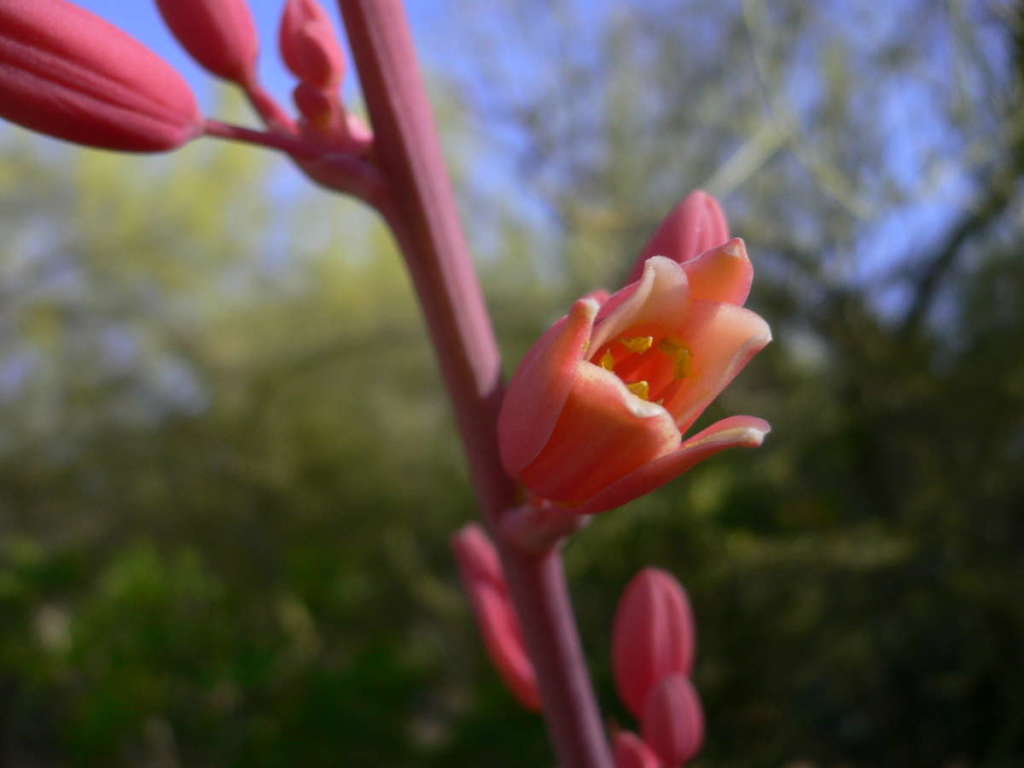
Red Yucca (Hesperaloe parviflora) is neither a yucca nor an aloe, but actually more closely related to agaves. Native to the Chihuahuan Desert, it is one of the go-to plants for Tucson landscapes and is common in highway medians because of its extreme drought and cold tolerance. Red flower stalks feature branches of salmon pink flowers attractive to hummingbirds.
Shapely Blooms

Arizona Passionflower (Passiflora arizonica) is found only in Pima and Santa Cruz counties in Arizona and in a few areas of northern Sonora, making it a true native. Also known as “fetid passionflower” for the disagreeable smell of its leaves, this perennial vine blooms in mid-summer. Highly structured flowers are noted for their crown of fleshy lavender-blue filaments and prominent yellow stamens – like a fanciful lady’s hat.
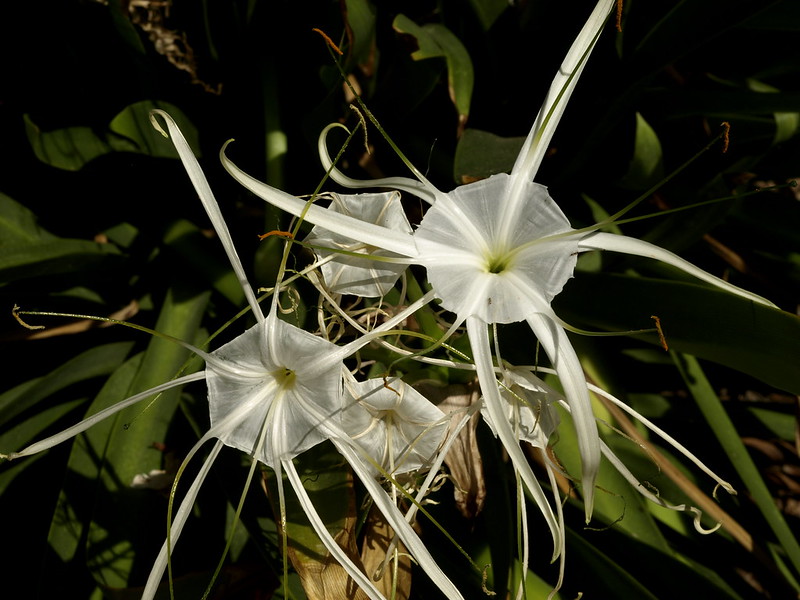
Related to amaryllis and also growing from bulbs underground, Sonoran Spider Lily (Hymenocallis sonorensis) prefers streamside habitats and wetlands. Long, narrow, deep green leaves are the perfect backdrop for its spider-shaped white flowers. The rather unique flowers are made up of six narrow, curved petals attached to a shallow cup formed from the fused stamens.

Looking like a yellow rocket in flight, the winged flowers of Golden Columbine (Aquilegia chrysantha) trail distinctive spurs. Growing in moist canyons in the Sonoran and Chihuahuan Deserts, it is the perfect candidate for a shade garden here in Tucson; its pollinators include both bees and butterflies. And interestingly, the name “columbine” comes from the Latin word for dove, referencing the flower’s resemblance to a group of doves.

Slipper Plant aka Lady’s Slipper (Pedilanthus macrocarpus) is a vertical, relatively leafless succulent that grows in clumps, its ½” thick stems rising up to 3’ tall. A member of the Euphorbia family, its origins are in the Sonoran Desert of northwest Mexico and central Baja California. Because of their resemblance to a lady’s slipper, the unusual reddish-orange flowers appearing along the stems in spring and summer, give the plant its common name.

As their name implies, pipevine swallowtail butterfly caterpillars are particularly fond of plants in the genus Aristolochia. While native to South America, White-veined Hardy Dutchman’s Pipe (Aristolochia fimbriata) is a perennial, vining groundcover with white-veined, heart-shaped leaves and totally bizarre flowers in green, maroon and yellow that resemble fringed elephant trunks.

Native to South Africa, starfish-flowered Stapelia (Stapelia grandiflora) can take some getting used to, but are certainly attention getting. If happy in their growing space, stapelia will flower spring, summer and fall. Also known as the carrion plant, this succulent produces massive, hairy flowers with the odor of rotten meat designed to attract their designated pollinator – flies.
Monsoon Blooms

Summer rains mean summer wildflowers like Arizona Poppy (Kallstroemia grandiflora) which will soon be popping up in sandy grasslands and along roadsides. Bright orangish-yellow with a reddish-orange basal spot in the center, the flowers resemble Mexican gold poppies and despite a lack of fragrance, attract a wide variety of pollinators. Its Spanish name is mal de ojos or “sore eyes” because some find the pollen irritating.

Preferring slightly higher elevations than the desert floor, Canyon Morning Glory (Ipomea barbatisepala) sprawls over rocks and other plants. Its slender vine and palmate leaves (shaped like a hand) give it a delicate appearance further enhanced by small trumpet-shaped bluish to pinkish-purple flowers. Though native, in Arizona it is listed as a noxious weed. What do you think?

Most remarkable about Devil’s Claw (Proboscidea althaeifolia) is its singular seed pod – a curved horn that splits into two claws as it dries. Growing from an underground tuber, the hairy, sticky stems and leaves are complemented by bell-shaped yellow flowers. Another Arizona species, P. parviflora var. hohokamiania was developed by the O’odham to produce larger seed pods for use in basketry; its flowers are white.
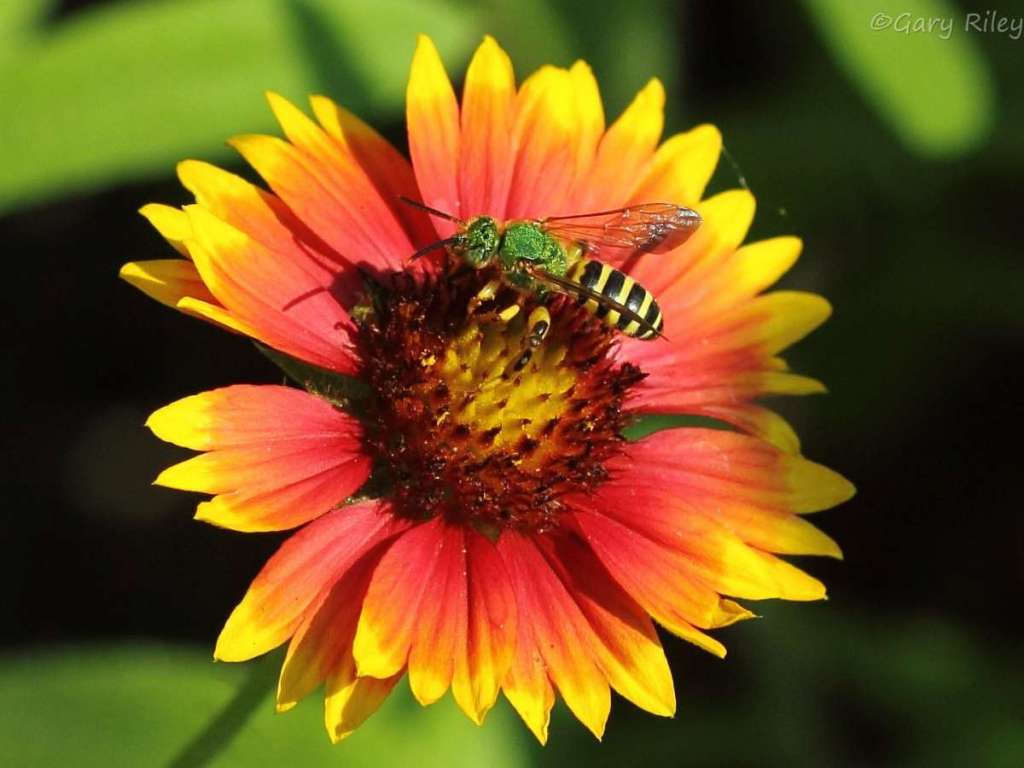
Aka Indian Blanket, aka Firewheel, Gaillardia pulchella is a popular annual for summer gardens but its native habitats are the windswept grasslands and dry plains of the West and Southwest. Its showy flowers are unmistakable – 1” to 2” across, the rays are red, tipped with yellow and each with three “teeth” at the wide end. The disc flowers in the center are brownish-red.

Cucurbita digitata, better known by its common name of Coyote Gourd vines relatively inconspicuously across the desert floor and sometimes along a fence, revealing itself with large yellow “squash” flowers. Pollinated by specialized squash bees, the resulting melon-shaped fruits are striped and mottled green, turning yellow as they ripen. Though bitter tasting, the seeds are edible and dried shells are used as containers.

Mexican Hat (Ratibida columnifera) is a fast-growing wildflower, not fussy about where you plant it. Named for their sombrero-look, the leafless stalks bear a single flower head composed of drooping rays in shades of dark red and yellow, all red or all yellow, surrounding a central brown disc that sticks up 1” or more above the petals. Heat tolerant and drought-resistant, the flowers provide for a mix of butterflies and bees.
Moon Gardening

Growing in clusters, the slender, cylindrical stems of Peniocereus serpentinus can grow to ten feet, sprawling along the ground unless supported by a nearby tree or shrub. Any wonder, its common name is Snake Cactus. The night-blooming flowers of this succulent rival those of its cousin, P. greggii, with pinkish-green edges and a fragrance like that of gardenias.

Sacred Datura (Datura wrightii) aka Jimson Weed has been made famous by the paintings of Georgia O’Keeffe. A member of the nightshade family, all parts of this summertime perennial are considered poisonous, though it has been used by several traditional peoples as a hallucinogenic. The large, white, trumpet-shaped flowers have a heady, sweet fragrance and are pollinated by hawk moths.

Whether you call it Tufted Evening Primrose, Desert Evening Primrose or Fragrant Evening Primrose, by any other name, Oenothera caespitosa is a fragrant perennial addition to a garden best enjoyed after dark. Its large white flowers, recognizable for their four heart-shaped petals and prominent yellow stamens, begin opening at twilight and close with the sun, turning pink as they wilt.

Native to South American, Zephyranthes candida is commonly called White Rain Lily due to the fact that it often blooms in response to significant rain events. The white flowers are delicate and graceful, growing on slender stalks in clumps of grass-like leaves. Here in the desert, provide some shade and supplemental water once the Monsoon ends to prevent the leaves dying back to the underground bulbs at the end of summer.

Night-blooming Hesperaloe (Hesperaloe nocturna) can grow to 5’ tall and almost as wide. Related to agaves, its leaves sprout from a central rosette, fine thread-like hairs “unraveling” along the leaf margins. From late spring into fall, long flower stalks appear bearing inconspicuous greenish-white flowers staying open into the day. Interestingly, the flowers do not open all at once, but a few at a time in no particular order.

Dependent on monsoon rains, Sweet Four O’Clock (Mirabilis longiflora) is another aromatic night-bloomer that does better at our elevation with filtered sun. Four-inch long, white, star-shaped flowers have a striking magenta “eye” and filaments, topped by tangerine stamens; their fragrance has been compared to that of an orange blossom. It is said Thomas Jefferson was gifted with M. longiflora seeds and grew the flowers at Monticello.
